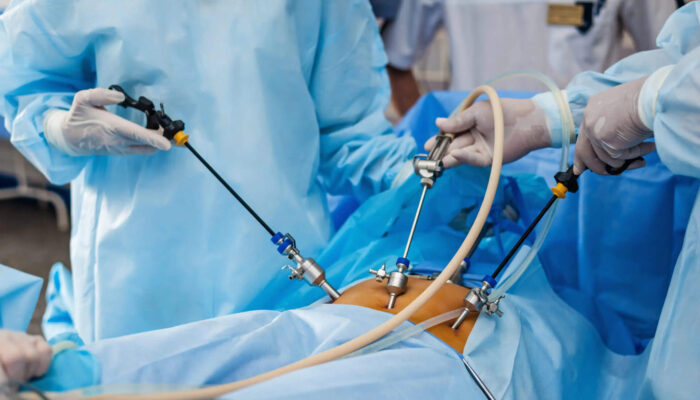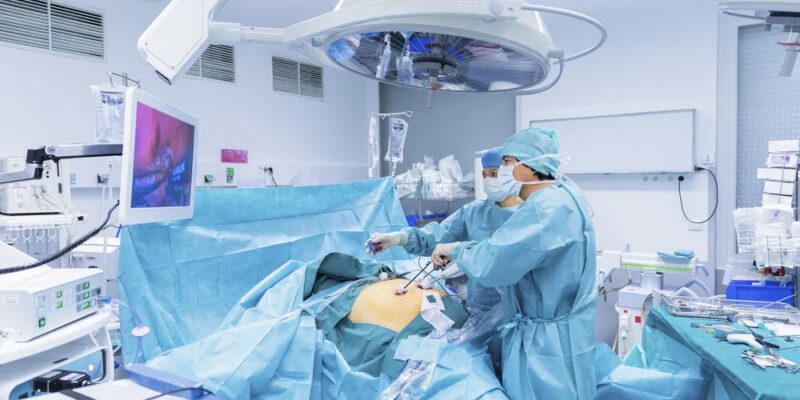Laparoscopy Surgery
Laparoscopy surgery is used for various procedures across different medical specialties, including gynecology, urology, general surgery, and more. It can be employed for both diagnostic purposes, such as exploring and evaluating the organs, as well as for therapeutic interventions, including removal of diseased tissue, organ repair, removal of tumors or cysts, and other surgical treatments. In our Create fertility clinic, laparoscopy surgery is a procedure that enables your specialist to look inside the abdominal and pelvic cavities to diagnose and treat a variety of abnormal conditions. The scope is passed through a tiny incision into the abdomen where images from the camera are projected onto a large monitor for the surgeon to view the abdominal pelvic cavity.
Diagnostic Laparoscopy
A laparoscopy surgery is a diagnostic treatment when the surgeon is viewing the abdominal cavity to make a diagnosis, without any treatment administered at that time. This is particularly useful for laparoscopy when other tests such as x-rays, scans, or blood work are inconclusive.
Operative Laparoscopy
A laparoscopy surgery is considered operative when the surgeon is treating a problem that is found during diagnostic laparoscopy with surgical instruments through the laparoscope. If your specialist sees an opportunity to repair a problem during a diagnostic Laparoscopy, an operative Laparoscopy will usually be performed at that time depending on the patient’s condition and the surgeon’s preference.

Laparoscopy surgery:
Anesthesia:
Before the laparoscopy surgery, the patient is usually given general anesthesia, which puts them to sleep or local anesthesia with sedation, which numbs the area and relaxes the patient.
Incision and insertion of the laparoscope:
The surgeon makes a few small incisions in the abdomen, which serve as ports for the laparoscopic instruments. Carbon dioxide gas is introduced into the abdomen to create space and improve visibility. The laparoscope, a long, thin tube with a camera and light source, is inserted through one of the incisions. It provides a magnified view of the internal organs on a monitor.
Exploration and surgical intervention:
With the laparoscope providing visual guidance, the surgeon can explore and evaluate the organs and structures within the abdomen and pelvis. Additional instruments, such as graspers, scissors, or cautery devices, are inserted through the other incisions. To perform the necessary surgical procedures. These can include removing diseased tissue, repairing organs, removing tumors or cysts, or performing other surgical interventions.
Closure:
After the surgical procedures are completed, the instruments are removed, and the incisions are closed with sutures, staples, or adhesive strips. In some cases, absorbable sutures may be used, eliminating the need for removal.

Do’s after Laparoscopy Surgery:
- Follow Medication Instructions:
Take any prescribed medications as directed by your surgeon, including pain relievers and antibiotics if prescribed.
- Rest:
Your body needs time to heal, so avoid strenuous activities and give yourself time to recover.
- Monitor Incisions:
Keep an eye on the incision sites for any signs of infection, such as redness, swelling, or increased pain. Notify your surgeon if you notice any concerning changes.
- Maintain Hygiene:
Keep the incision areas clean and dry.
- Wear Loose Clothing:
Wear loose-fitting and comfortable clothing to avoid putting pressure on the incision sites.
- Gentle Movements:
When moving or getting out of bed, do so slowly and gently to avoid strain on the abdominal muscles.
- Take Deep Breaths:
Practice deep breathing exercises to help prevent respiratory complications and improve lung function.
- Attend Follow-Up Appointments:
Make sure to attend all scheduled postoperative follow-up appointments with your surgeon to monitor your recovery progress.
Don’ts after Laparoscopy Surgery:
- Lift Heavy Objects:
Avoid lifting heavy objects or engaging in strenuous activities for the first few weeks after surgery to prevent strain on the incision sites.
- Drive Too Soon:
Refrain from driving until you are no longer taking pain medications and feel comfortable moving without discomfort.
- Ignore Pain or Complications:
Report any unusual or severe pain, fever, or other complications to your surgeon promptly.
- Skip Medications:
Stick to the prescribed medication regimen and do not skip doses unless instructed otherwise by your surgeon.
- Submerge in Water:
Avoid swimming or submerging the incision sites in water until they are fully healed to reduce the risk of infection.
- Overexert:
Avoid overexertion, and listen to your body’s signals to prevent pushing yourself too soon after surgery.
- Smoke or Consume Alcohol:
It’s best to refrain from these activities during your recovery.




4 Comments